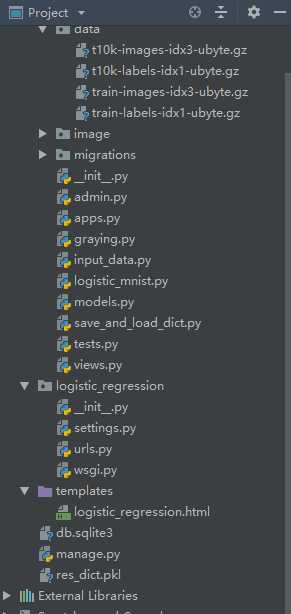标签:render sam ace examples http eth abs dom creat
1.工程概要

2.data文件以及input_data文件准备
链接:https://pan.baidu.com/s/1EBNyNurBXWeJVyhNeVnmnA
提取码:4nnl
3.logisstic_mnist.py
def logistic_regression():
import tensorflow as tf
import matplotlib.pyplot as plt
from app01 import input_data
import numpy as np
from PIL import Image
print(‘Download and Extract MNIST dataset‘)
mnist = input_data.read_data_sets(‘app01/data/‘, one_hot=True)
print("type of ‘mnist‘ is %s" % (type(mnist)))
print("number of train data is %d" % (mnist.train.num_examples))
print("number of test data is %d" % (mnist.test.num_examples))
trainimg = mnist.train.images
for img in trainimg:
for i in range(0, 748):
if img[i] < 0.6:
img[i] = 0
else:
img[i] = 1
trainlabel = mnist.train.labels
testimg = mnist.test.images
for img in testimg:
for i in range(0, 748):
if img[i] < 0.6:
img[i] = 0
else:
img[i] = 1
testlabel = mnist.test.labels
print("type of the ‘trainimg‘ is %s" % (type(trainimg)))
print("type of the ‘trainlabel‘ is %s" % (type(trainlabel)))
print("type of the ‘testimg‘ is %s" % (type(testimg)))
print("type of the ‘testlabel‘ is %s" % (type(testlabel)))
print("shape of the ‘trainimg‘ is %s" % (trainimg.shape,))
print("shape of the ‘trainlabel‘ is %s" % (trainlabel.shape,))
print("shape of the ‘testimg‘ is %s" % (testimg.shape,))
print("shape of the ‘testlabel‘ is %s" % (testlabel.shape,))
print(‘how dose the training data look like?‘)
nsample = 5
randidx = np.random.randint(trainimg.shape[0], size=nsample)
for i in randidx:
curr_img = np.reshape(trainimg[i, :], (28, 28))
curr_label = np.argmax(trainlabel[i, :])
plt.matshow(curr_img, cmap=plt.get_cmap(‘gray‘))
plt.title(""+str(i)+"th Training Data"+"Label is"+str(curr_label))
print(""+str(i)+"th Training Data"+"Label is"+str(curr_label))
plt.show()
print(‘Batch Learning?‘)
batch_size = 100
batch_xs, batch_ys = mnist.train.next_batch(batch_size)
print("type of ‘batch_xs‘ is %s" % (type(batch_xs)))
print("type of ‘batch_ys‘ is %s" % (type(batch_ys)))
print("shape of ‘batch_xs‘ is %s" % (batch_xs.shape, ))
print("shape of ‘batch_ys‘ is %s" % (batch_ys.shape, ))
# print(trainlabel[0])
x = tf.placeholder(‘float‘, [None, 784])
y = tf.placeholder(‘float‘, [None, 10])
W = tf.Variable(tf.zeros([784, 10]))
b = tf.Variable(tf.zeros([10]))
actv = tf.nn.softmax(tf.matmul(x, W) + b)
cost = tf.reduce_mean(-tf.reduce_sum(y*tf.log(actv), reduction_indices=1))
learning_rate = 0.01
optm = tf.train.GradientDescentOptimizer(learning_rate).minimize(cost)
pred = tf.equal(tf.argmax(actv, 1), tf.argmax(y, 1))
accr = tf.reduce_mean(tf.cast(pred, ‘float‘))
init = tf.global_variables_initializer()
sess = tf.InteractiveSession()
training_epochs = 50
batch_size = 100
display_step = 5
sess = tf.Session()
sess.run(init)
for epoch in range(training_epochs):
avg_cost = 0.
num_batch = int(mnist.train.num_examples/batch_size)
for i in range(num_batch):
batch_xs, batch_ys = mnist.train.next_batch(batch_size)
feeds = {x: batch_xs, y: batch_ys}
sess.run(optm, feed_dict=feeds)
avg_cost += sess.run(cost, feed_dict=feeds)/num_batch
if epoch % display_step == 0:
feeds_train = {x: batch_xs, y: batch_ys}
feeds_test = {x: mnist.test.images, y: mnist.test.labels}
train_acc = sess.run(accr, feed_dict=feeds_train)
test_acc = sess.run(accr, feed_dict=feeds_test)
print("Epoch: %03d/%03d cost: %.9f train_acc: %.3f test_acc: %.3f" % (epoch, training_epochs, avg_cost, train_acc, test_acc))
W_out = W.eval(session=sess)
b_out = b.eval(session=sess)
res_dict = {‘W‘: W_out, ‘b‘: b_out}
print(‘DONE‘)
return res_dict
4.views.py
from django.shortcuts import render
from app01 import logistic_mnist as lomni
from app01 import save_and_load_dict as save_load
# Create your views here.
def index(request):
if request.method == ‘GET‘:
return render(request, ‘logistic_regression.html‘, {‘range‘: range(0, 28)})
if request.method == ‘POST‘:
choice = request.GET.get(‘n‘)
print(‘choice:‘, choice)
if choice == ‘1‘:
res_dict = lomni.logistic_regression()
save_load.save_obj(res_dict, ‘res_dict‘)
return render(request, ‘logistic_regression.html‘, {‘resdict‘: res_dict})
if choice == ‘2‘:
import numpy as np
my_test = []
for row in range(0, 28):
for line in range(0, 28):
if request.POST.get(‘(‘+str(row)+‘,‘+str(line)+‘)‘) == None:
my_test.append(0)
else:
my_test.append(1)
my_test = np.array(my_test)
print(‘my_test:‘, my_test)
res_dict = save_load.load_obj(‘res_dict‘)
W = np.array(res_dict[‘W‘])
b = np.array(res_dict[‘b‘])
# print(W, b)
pred = np.argmax(np.matmul(my_test, W)+b)
return render(request, ‘logistic_regression.html‘, {‘resdict‘: res_dict, ‘pred‘:pred})
if choice == ‘3‘:
import numpy as np
from PIL import Image
img = Image.open(‘app01/image/sharped5.png‘)
img_array = np.array(img)
img_array = np.zeros(784).reshape(28, 28)
print(img_array + 0)
return render(request, ‘logistic_regression.html‘, {‘img_array‘: img_array+0, ‘range‘: range(0, 28)})
5.urls.py
"""logistic_regression URL Configuration
The `urlpatterns` list routes URLs to views. For more information please see:
https://docs.djangoproject.com/en/2.1/topics/http/urls/
Examples:
Function views
1. Add an import: from my_app import views
2. Add a URL to urlpatterns: path(‘‘, views.home, name=‘home‘)
Class-based views
1. Add an import: from other_app.views import Home
2. Add a URL to urlpatterns: path(‘‘, Home.as_view(), name=‘home‘)
Including another URLconf
1. Import the include() function: from django.urls import include, path
2. Add a URL to urlpatterns: path(‘blog/‘, include(‘blog.urls‘))
"""
from django.contrib import admin
from django.urls import path
from app01 import views
urlpatterns = [
path(‘admin/‘, admin.site.urls),
path(‘index/‘, views.index),
]
6.logistic_regression.html
<!DOCTYPE html>
<html lang="en">
<head>
<meta charset="UTF-8">
<title>Title</title>
<style>
</style>
</head>
<body>
<form action="/index/?n=1" method="post">
{% csrf_token %}
<input type="submit" value="逻辑回归训练">
</form>
{% if resdict != none %}
<div>
<p>训练结果:</p>
<p>W:{{ resdict.W }}</p>
<p>b:{{ resdict.b }}</p>
</div>
{% endif %}
<form action="/index/?n=2" method="post">
{% csrf_token %}
<table border="1">
<thead></thead>
<tbody >
{% for row in range %}
<tr>
{% for line in range %}
<td>
<input type="checkbox" name="({{ row }},{{ line }})" class="paint">
</td>
{% endfor %}
</tr>
{% endfor %}
</tbody>
</table>
<input type="submit" value="进行手写识别">
</form>
{% if pred != none %}
<div>
<p>
检测结果是{{ pred }}
</p>
</div>
{% endif %}
<form action="/index/?n=3" method="post">
{% csrf_token %}
<input type="submit" value="开始检测目标文件夹中的手写字体!">
<p>{{ img }}</p>
</form>
</body>
</html>
7.save_and_load_dict.py
<!DOCTYPE html>
<html lang="en">
<head>
<meta charset="UTF-8">
<title>Title</title>
<style>
</style>
</head>
<body>
<form action="/index/?n=1" method="post">
{% csrf_token %}
<input type="submit" value="逻辑回归训练">
</form>
{% if resdict != none %}
<div>
<p>训练结果:</p>
<p>W:{{ resdict.W }}</p>
<p>b:{{ resdict.b }}</p>
</div>
{% endif %}
<form action="/index/?n=2" method="post">
{% csrf_token %}
<table border="1">
<thead></thead>
<tbody >
{% for row in range %}
<tr>
{% for line in range %}
<td>
<input type="checkbox" name="({{ row }},{{ line }})" class="paint">
</td>
{% endfor %}
</tr>
{% endfor %}
</tbody>
</table>
<input type="submit" value="进行手写识别">
</form>
{% if pred != none %}
<div>
<p>
检测结果是{{ pred }}
</p>
</div>
{% endif %}
<form action="/index/?n=3" method="post">
{% csrf_token %}
<input type="submit" value="开始检测目标文件夹中的手写字体!">
<p>{{ img }}</p>
</form>
</body>
</html>
8.graying.py
import sys
print(sys.argv[0])
import os
path_curr = os.path.abspath(‘.‘)
path_up = os.path.abspath(‘..‘)
print(path_up)
threshold = 140
table = []
for a in range(256):
if a > threshold:
table.append(1)
else:
table.append(0)
from PIL import Image
for i in range(0, 10):
img = Image.open(‘image/‘+str(i)+‘.png‘)
Img = img.convert(‘L‘)
Img.save(‘image/grey‘+str(i)+‘.png‘)
photo = Img.point(table, ‘1‘)
photo.save(‘image/sharped‘+str(i)+‘.png‘)
python_tensorflow_Django实现逻辑回归
标签:render sam ace examples http eth abs dom creat
原文地址:https://www.cnblogs.com/CK85/p/10253753.html